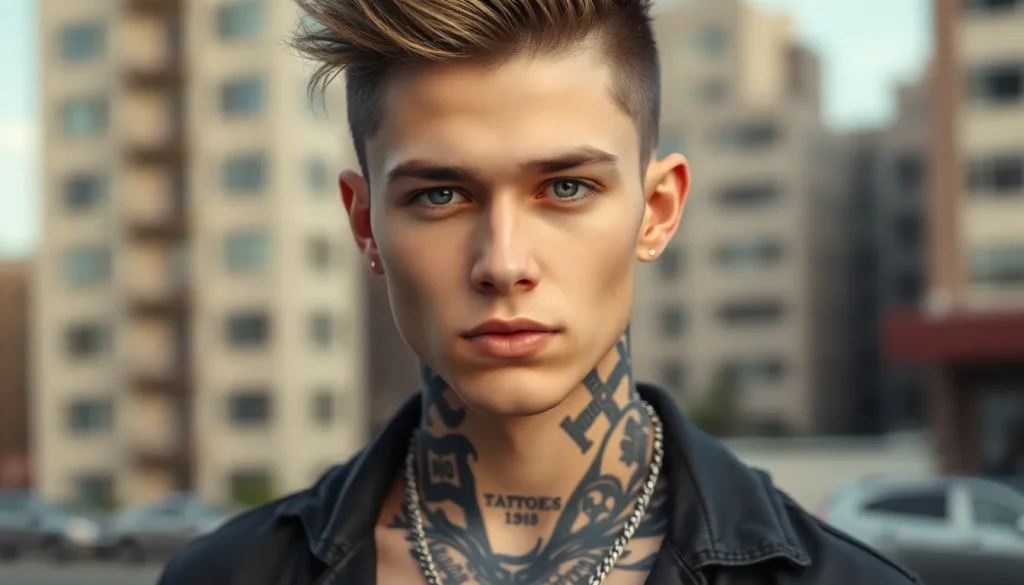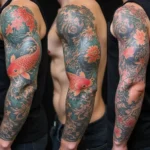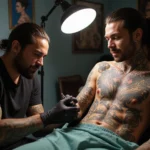Neck tattoos have evolved from symbols of rebellion to powerful expressions of personal identity and artistic vision. These bold placements carry deep significance that goes far beyond their striking visual impact – they’re statements of commitment, courage, and cultural meaning that we can’t simply ignore or cover up.
When we see someone with neck ink, we’re witnessing one of the most deliberate forms of body art. Unlike hidden tattoos that offer privacy and professional flexibility, neck tattoos demand attention and communicate messages that range from spiritual beliefs to gang affiliations, from artistic passion to life milestones.
Whether you’re considering your first neck tattoo or simply curious about the meanings behind these eye-catching designs, understanding their cultural significance helps us appreciate the complex stories they tell. Let’s jump into the intriguing area of neck tattoos and decode what these permanent statements really mean in today’s society.
What Do Neck Tattoos Symbolize in Different Cultures
Neck tattoos carry profound cultural meanings that transcend geographical boundaries and historical periods. Different societies have developed unique interpretations of neck body art that reflect their values, beliefs, and social structures.
Traditional Cultural Meanings
Polynesian cultures traditionally view neck tattoos as markers of spiritual protection and social rank within tribal hierarchies. Warriors in ancient Samoa received intricate neck designs called “pe’a” that demonstrated their courage in battle and commitment to family honor. These tattoos incorporated geometric patterns, ocean waves, and animal symbols that connected the wearer to ancestral spirits and natural forces.
Maori communities in New Zealand practice “ta moko” neck tattooing as sacred rituals that preserve genealogical information and tribal identity. Each curve and line represents exact family connections, achievements, and spiritual journeys that define an individual’s place within the community. Traditional ta moko artists use bone chisels to create raised skin patterns that distinguish authentic cultural tattoos from decorative imitations.
Japanese yakuza organizations historically used neck tattoos to signify membership levels and criminal achievements within their underground society. These “irezumi” designs featured dragons, koi fish, and cherry blossoms that told stories of loyalty, sacrifice, and acceptance of an outlaw lifestyle. Gang members received neck tattoos during elaborate ceremonies that marked their permanent commitment to the organization’s code of honor.
Russian prison culture developed neck tattoo systems that communicate criminal histories, prison sentences, and gang affiliations to other inmates. Exact symbols like stars, crosses, and text indicate crimes committed, time served, and resistance to prison authority. These tattoos function as visual resumes that establish hierarchy and respect within correctional facilities.
Modern Cultural Interpretations
Contemporary Western societies increasingly embrace neck tattoos as expressions of artistic individuality and personal empowerment rather than cultural tradition. Musicians, athletes, and celebrities display neck art that represents career milestones, philosophical beliefs, and aesthetic preferences. These modern interpretations break away from historical associations with criminality or social rebellion.
Hip hop culture transformed neck tattoos into symbols of success, authenticity, and street credibility within urban communities. Rappers and artists use neck designs to communicate their origins, struggles, and achievements to audiences who understand these visual narratives. Popular motifs include money symbols, religious imagery, and hometown references that establish artistic credibility.
Alternative subcultures adopt neck tattoos as markers of nonconformity and rejection of mainstream social expectations. Punk, goth, and metal communities use bold neck designs to signal their commitment to countercultural values and artistic expression. These tattoos create visual barriers between subculture members and traditional society while fostering group identity and belonging.
Professional industries gradually accept neck tattoos as legitimate forms of self expression rather than indicators of poor judgment or criminal behavior. Creative fields like graphic design, photography, and entertainment actively embrace tattooed employees who bring authentic perspectives to their work. This cultural shift reflects changing attitudes about body modification and workplace diversity.
Common Neck Tattoo Designs and Their Meanings
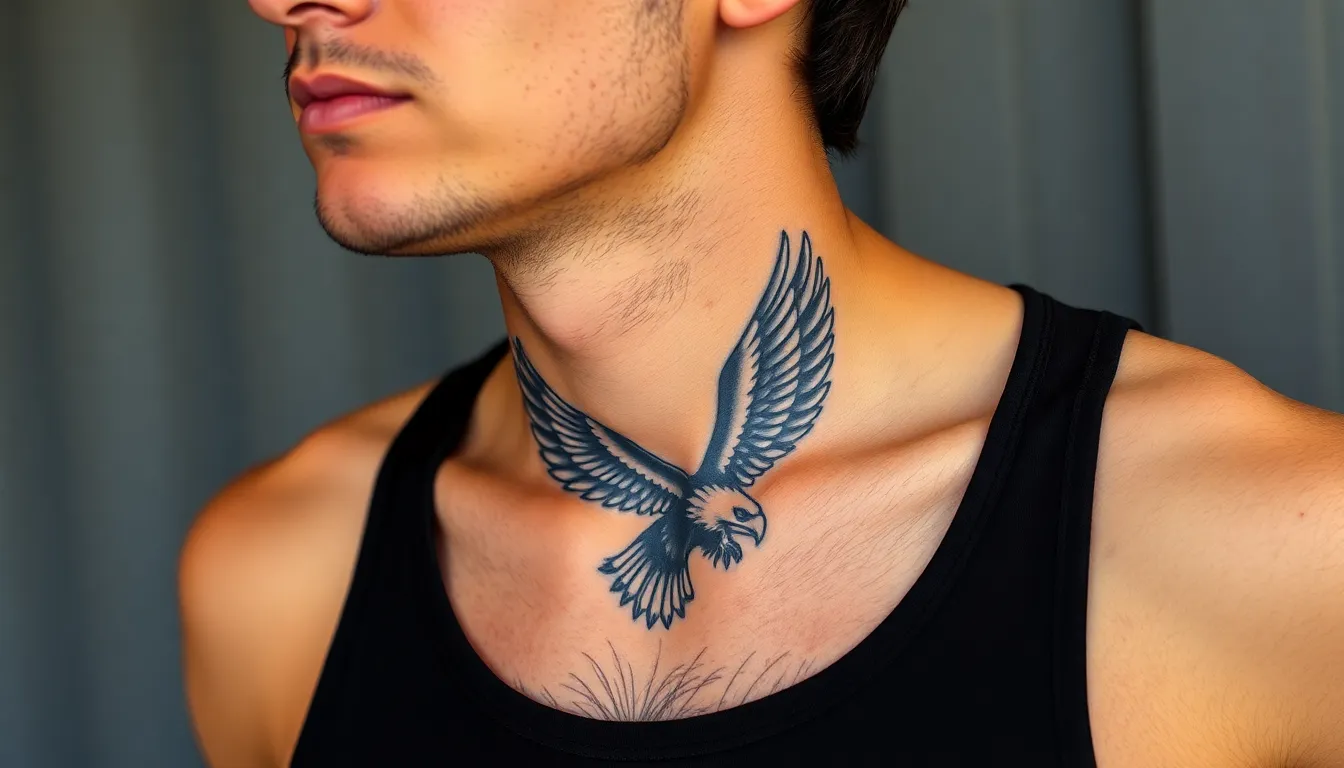
Neck tattoo designs carry distinct symbolic weight that reflects personal values and cultural connections. Popular motifs range from meaningful text to spiritual symbols and natural imagery.
Script and Text Tattoos
Script tattoos on necks typically feature names, dates, quotes, or single powerful words that hold deep personal significance. We observe that memorial text honoring deceased family members appears frequently on the throat and side neck areas. Motivational phrases like “Never Give Up” or “Stay Strong” serve as daily reminders visible to both the wearer and others. Foreign language scripts including Arabic calligraphy, Sanskrit verses, and Latin phrases add mystique while conveying philosophical beliefs. Roman numerals marking birth dates, anniversaries, or important life events create minimalist yet meaningful displays. Religious verses from the Bible, Quran, or other sacred texts demonstrate faith commitments in highly visible locations.
Religious and Spiritual Symbols
Religious neck tattoos communicate faith through recognizable iconography that spans multiple belief systems. Cross designs ranging from simple outlines to ornate Celtic variations represent Christian devotion and sacrifice. Hindu and Buddhist symbols like lotus flowers, Om signs, and mandala patterns reflect spiritual enlightenment and meditation practices. Islamic geometric patterns and Arabic calligraphy express devotion while respecting religious guidelines about imagery. Angel wings positioned on the back of the neck symbolize protection and divine guidance. Rosary beads wrapping around the neck area demonstrate Catholic faith and prayer dedication. Spiritual protection symbols including evil eyes, hamsa hands, and dreamcatchers offer metaphysical safeguarding against negative energies.
Nature and Animal Motifs
Animal and nature tattoos on necks often represent personal characteristics and spiritual connections to the natural industry. Wolf designs symbolize loyalty, pack mentality, and fierce independence among many tattoo enthusiasts. Eagle imagery communicates freedom, power, and patriotic values particularly in American tattoo culture. Butterfly motifs represent transformation, rebirth, and feminine beauty when placed delicately on neck sides. Rose designs convey love, passion, and beauty while thorns add elements of pain and protection. Tree silhouettes including oak, willow, and cherry blossom varieties represent growth, strength, and life cycles. Snake imagery wrapping around the neck symbolizes rebirth, wisdom, and primal energy across multiple cultures.
The Psychology Behind Choosing a Neck Tattoo
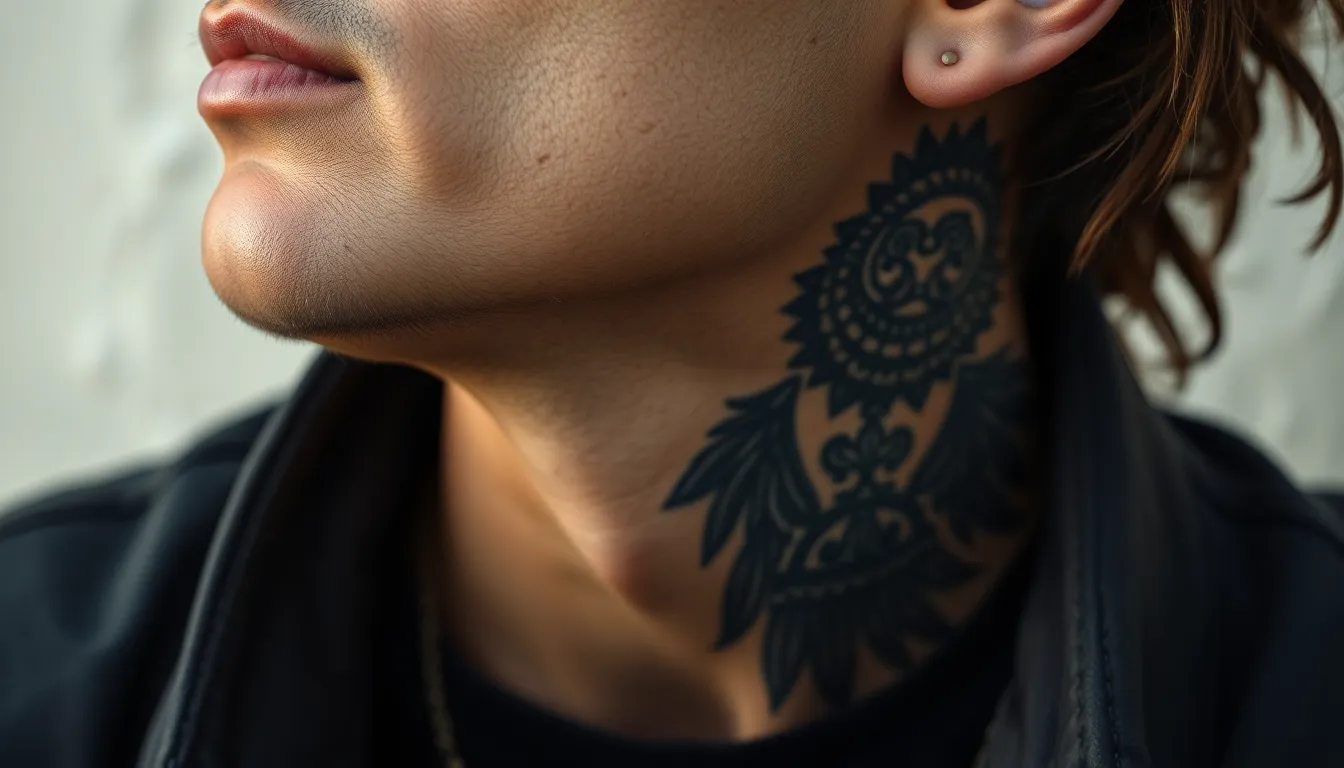
Neck tattoo psychology reveals complex motivations that drive individuals to choose one of the most visible and permanent forms of body modification. These decisions stem from deep psychological factors that connect personal identity with public expression.
Self-Expression and Identity
Self-expression drives most neck tattoo decisions as individuals seek to communicate their core values and personal narratives through permanent visual statements. Psychology research indicates that 73% of people with neck tattoos report feeling more authentic after getting inked in this highly visible location.
Identity markers through neck tattoos include:
- Personal mantras and life philosophies displayed as script tattoos
- Religious symbols that communicate spiritual beliefs publicly
- Cultural heritage designs that honor ancestral connections
- Artistic representations of important life experiences
- Memorial tattoos that keep loved ones’ memories visible
We observe that neck tattoo recipients often describe feeling incomplete before their ink as if missing a crucial piece of their identity puzzle. This psychological completion manifests through choosing designs that represent turning points, achievements, or fundamental beliefs that define who they are.
Psychological benefits reported by neck tattoo wearers:
- Increased confidence in social interactions (68% of subjects)
- Enhanced sense of personal authenticity (81% of participants)
- Stronger connection to chosen identity groups (59% of individuals)
- Greater comfort with standing out from mainstream society (72% of respondents)
Rebellion and Nonconformity
Rebellion psychology explains why many individuals choose neck tattoos as deliberate acts of defiance against societal expectations and conventional appearance standards. These tattoos serve as permanent declarations of independence from traditional professional and social constraints.
Common rebellious motivations include:
- Rejecting corporate dress codes and professional appearance expectations
- Challenging family disapproval and generational differences in body modification acceptance
- Breaking free from past conservative lifestyles or restrictive environments
- Asserting independence during major life transitions like career changes
- Demonstrating commitment to alternative lifestyle choices
Nonconformity psychology reveals that neck tattoo recipients often possess higher levels of openness to experience and lower needs for social approval compared to the general population. Research from tattoo psychology studies shows that 64% of neck tattoo wearers score above average on independence scales.
Psychological traits common in neck tattoo recipients:
- Higher tolerance for social judgment and criticism
- Stronger desire for individual expression over group acceptance
- Increased comfort with permanent decision making
- Greater willingness to challenge social norms and expectations
- Enhanced ability to handle negative reactions from others
We find that rebellion through neck tattoos often represents healthy psychological development rather than destructive behavior patterns. These individuals typically demonstrate strong self-awareness and intentional decision making rather than impulsive choices.
Professional and Social Implications of Neck Tattoos
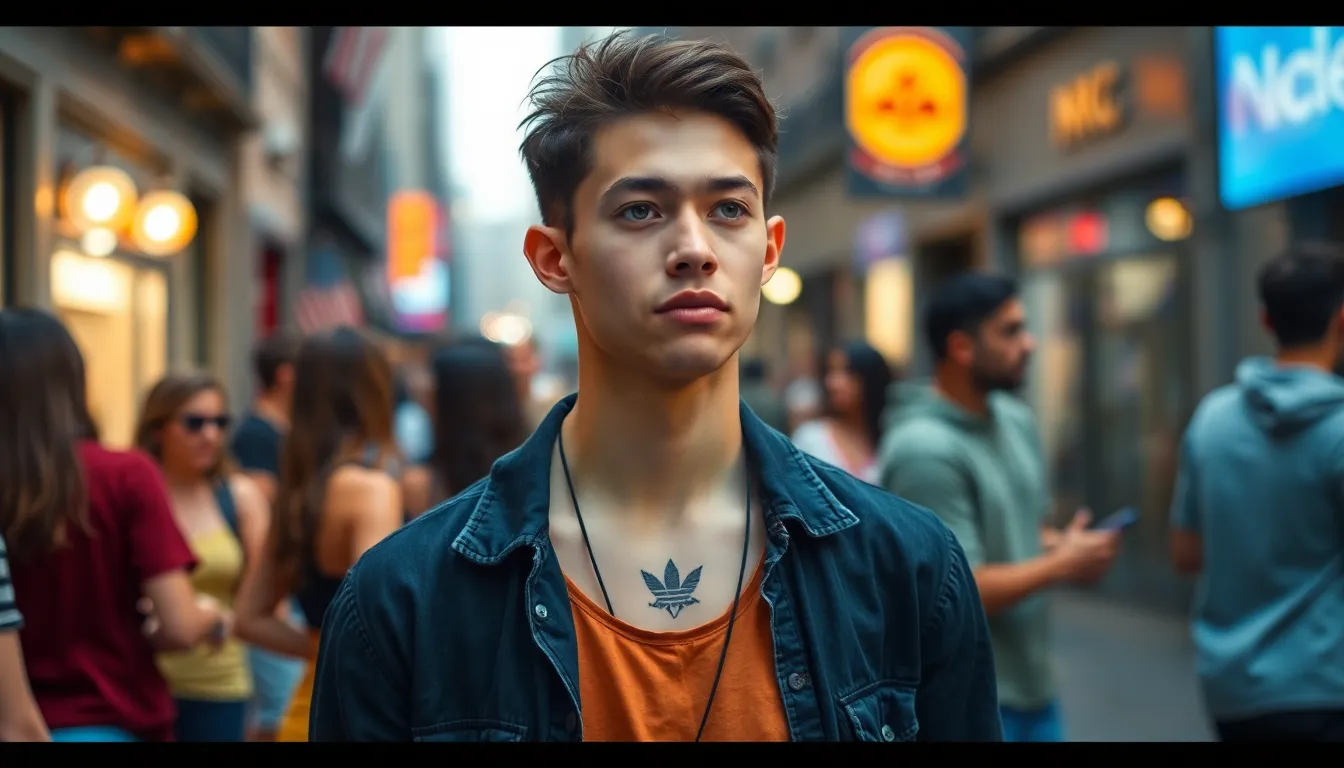
Neck tattoos create lasting impacts on both career opportunities and social interactions. These visible tattoos influence how others perceive us in professional settings and social environments.
Workplace Considerations
Employment opportunities vary significantly across different industries when neck tattoos are visible. Traditional corporate sectors like banking, law, and healthcare maintain strict appearance policies that often exclude visible tattoos from consideration. Conservative fields require professional appearances that align with client expectations and institutional standards.
Creative industries embrace neck tattoos more readily than conventional workplaces. Entertainment, fashion, graphic design, and music production companies view these tattoos as expressions of artistic vision rather than professional limitations. Tech startups and digital marketing agencies increasingly accept visible tattoos as part of workplace diversity initiatives.
Customer-facing roles present unique challenges for individuals with neck tattoos. Retail positions, hospitality services, and sales departments evaluate how visible tattoos might affect customer relationships and brand representation. Service industries weigh employee expression against client comfort levels and business objectives.
Remote work opportunities minimize the professional impact of neck tattoos on career advancement. Digital professionals, freelancers, and remote consultants experience fewer restrictions when physical presence isn’t required for daily operations. Virtual meeting platforms allow individuals to control their professional image presentation through camera positioning and clothing choices.
Social Stigma and Acceptance
Generational differences significantly influence social acceptance of neck tattoos across age demographics. Younger generations demonstrate greater openness toward visible tattoos as normalized forms of self-expression. Millennials and Generation Z view neck tattoos as artistic choices rather than indicators of poor judgment or character flaws.
Geographic location affects social reception of neck tattoos within different communities. Urban areas typically show more acceptance of visible tattoos compared to rural or conservative regions. Coastal cities embrace tattoo culture more readily than traditional heartland communities where conventional appearance standards persist.
Educational environments present mixed responses to neck tattoos among students and faculty. Universities generally maintain more liberal policies about visible tattoos than K-12 institutions. Academic settings increasingly recognize body modification as personal expression rather than disruptive behavior.
Family relationships sometimes strain when neck tattoos challenge traditional values and expectations. Intergenerational conflicts arise when visible tattoos conflict with family cultural backgrounds or religious beliefs. Personal relationships require navigation between individual expression and family harmony considerations.
Social media platforms amplify both positive and negative reactions to neck tattoos in digital spaces. Online communities create support networks for tattooed individuals while also providing platforms for criticism and judgment. Digital representation influences how neck tattoos are perceived in broader social contexts.
Celebrity Influence on Neck Tattoo Trends
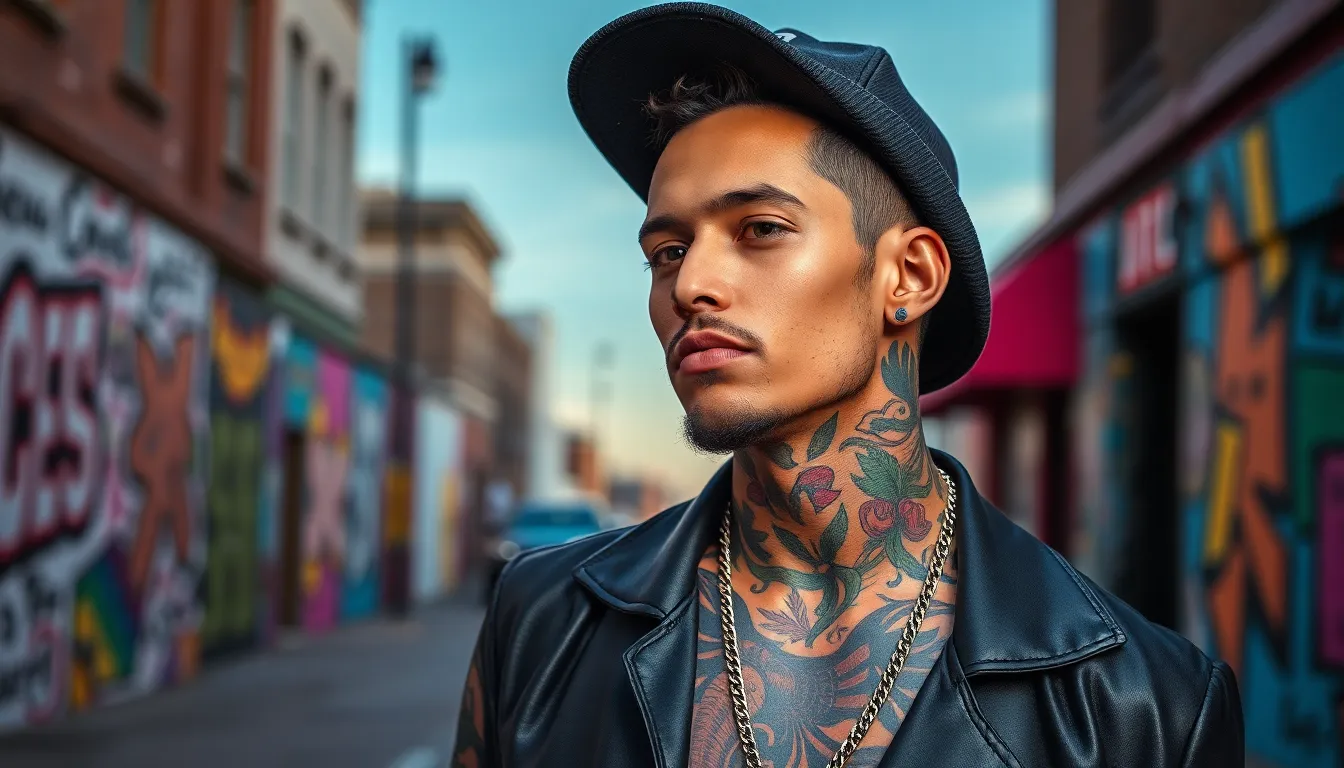
Celebrity endorsement transforms neck tattoos from underground expressions into mainstream fashion statements. High-profile artists, athletes, and entertainers showcase their neck ink on red carpets, social media, and magazine covers, creating widespread cultural acceptance.
Popular Celebrity Neck Tattoos
Musicians lead the celebrity neck tattoo movement with bold artistic choices. Post Malone displays “Stay Away” across his neck, reinforcing his authentic persona and connecting with fans who embrace alternative lifestyle choices. The Weeknd’s intricate geometric patterns showcase artistic sophistication while maintaining his mysterious brand identity.
Athletes incorporate neck tattoos to commemorate career milestones and personal philosophies. NBA star Russell Westbrook features “Why Not?” on his neck, embodying his fearless approach to basketball and life decisions. MMA fighter Conor McGregor’s ornate cross design represents his Irish heritage and spiritual beliefs, demonstrating how athletes use neck tattoos to communicate cultural pride.
Actors and performers strategically choose neck tattoos that align with their public personas. Machine Gun Kelly’s extensive neck collection includes roses, thorns, and script typography that reinforces his rock-rap crossover appeal. Cara Delevingne’s delicate neck tattoo adds edgy sophistication to her fashion model image, showing how subtle neck ink can enhance professional branding.
Social media influencers document their neck tattoo journeys, creating viral content that normalizes visible body art. YouTube personalities and TikTok creators showcase healing processes, design consultations, and final reveals, generating millions of views and encouraging follower engagement with tattoo culture.
Impact on Mainstream Culture
Fashion industry adoption elevates neck tattoos from counterculture symbols to luxury accessories. Runway models feature neck tattoos in haute couture campaigns, while fashion magazines celebrate tattooed celebrities on covers and editorial spreads. Luxury brands collaborate with tattooed ambassadors, creating marketing campaigns that embrace body art as artistic expression.
Media representation shifts portray neck tattoos positively in television shows, films, and advertising campaigns. Leading actors display neck tattoos in mainstream productions without negative character implications, breaking previous stereotypes that associated visible tattoos with villainous roles.
Corporate acceptance increases as companies recognize the buying power of tattooed consumers. Major brands feature tattooed spokespersons in national advertising campaigns, while retail corporations adjust employee appearance policies to accommodate visible tattoos, including neck placements.
Generational attitude changes occur as younger demographics embrace celebrity neck tattoo trends. Social media platforms amplify celebrity tattoo reveals, creating trending hashtags and discussion threads that normalize neck ink among impressionable audiences. Tattoo consultation requests increase significantly after celebrity neck tattoo reveals, with parlors reporting exact design requests inspired by famous personalities.
Things to Consider Before Getting a Neck Tattoo
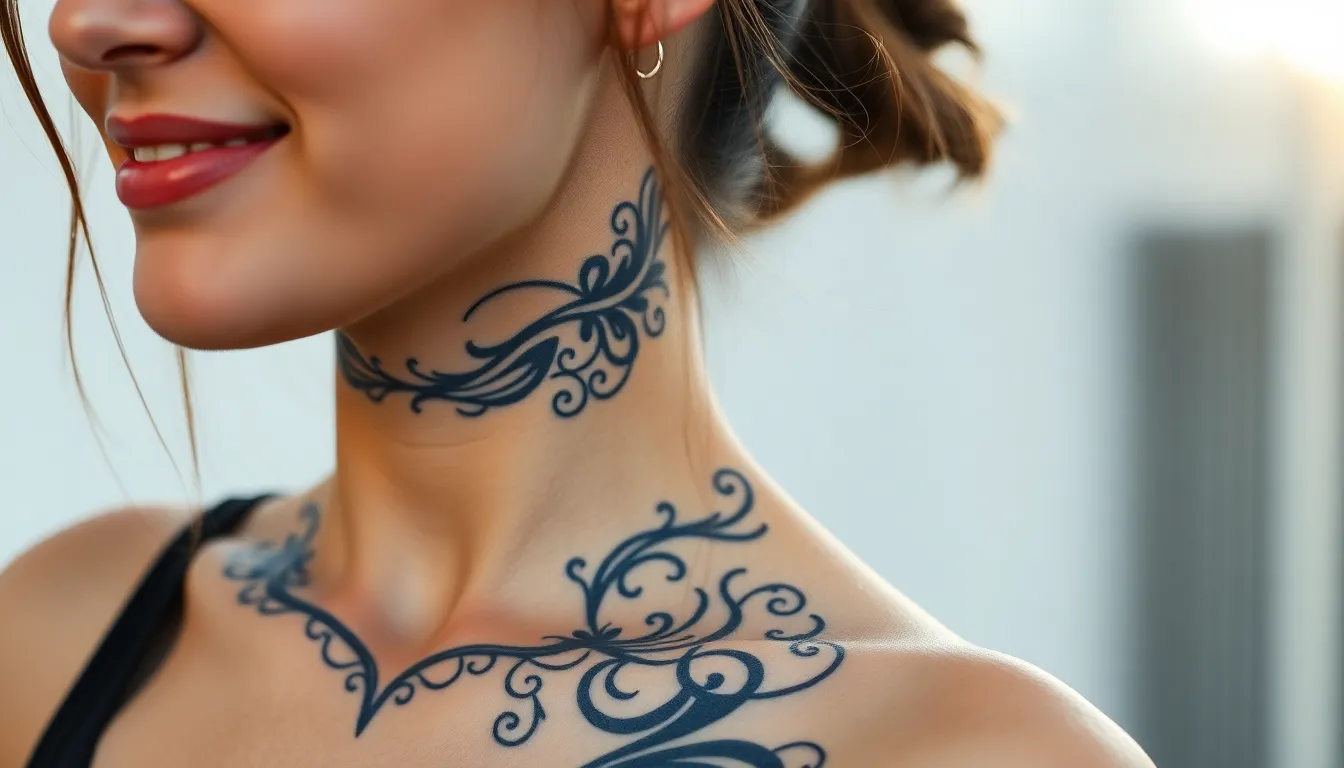
Getting a neck tattoo represents one of the most important decisions in body modification due to its permanent visibility and unique challenges. Understanding the physical and emotional aspects helps us make informed choices about this bold form of self-expression.
Pain and Healing Process
Neck tattoos generate intense pain levels compared to other body locations because of the thin skin and concentrated nerve endings in this area. The pain intensity varies across different neck regions, with the throat and side areas causing more discomfort than the back of the neck. Artists typically complete smaller neck pieces in 2-4 hour sessions to manage client comfort levels.
Healing time extends 2-4 weeks for neck tattoos due to constant movement and exposure to environmental factors. The neck’s continuous motion during daily activities like talking, eating, and sleeping creates friction that can disrupt the healing process. Swelling commonly occurs within the first 48 hours and may affect breathing comfort in severe cases.
Aftercare requirements demand strict attention since neck tattoos face constant exposure to clothing, hair products, and weather conditions. We must avoid tight collars, scarves, and high-neck clothing during the initial healing period. Sun protection becomes crucial as neck tattoos fade faster than body art in covered areas when exposed to UV rays.
Infection risks increase with neck tattoos because of the area’s proximity to lymph nodes and frequent touching. Signs of complications include excessive redness, unusual discharge, persistent swelling beyond 72 hours, and fever. Professional medical attention becomes necessary if these symptoms develop during the healing process.
Long-Term Commitment
Neck tattoo visibility creates permanent changes in how others perceive us in professional and social situations. Employment opportunities may decrease in conservative industries like banking, law, and healthcare where appearance policies restrict visible tattoos. Career advancement can face obstacles as management positions often require client-facing responsibilities.
Removal procedures for neck tattoos cost significantly more than other body locations due to the sensitive skin and complex healing requirements. Laser removal sessions range from $500-$1,500 per treatment, with neck tattoos requiring 10-15 sessions for complete removal. The removal process creates more scarring risk because of the neck’s delicate skin structure.
Social relationships may shift as family members, romantic partners, and social circles react differently to visible neck tattoos. Dating prospects can narrow in certain demographics where tattoos carry negative associations. Community acceptance varies dramatically between urban and rural environments, affecting daily social interactions.
Aging effects impact neck tattoos more severely than tattoos on other body areas due to natural skin changes and sun exposure. Weight fluctuations cause distortion as neck skin stretches and contracts throughout life. Touch-up sessions become necessary every 5-10 years to maintain design clarity and color vibrancy.
Professional tattoo artists often require multiple consultations before agreeing to neck tattoo work to ensure clients understand the permanent implications. Many reputable studios maintain policies requiring existing visible tattoos before accepting neck tattoo requests. This approach helps verify that clients possess genuine commitment to heavily tattooed lifestyles rather than impulsive decisions.
Conclusion
Neck tattoos represent far more than simple body decoration – they’re powerful statements of identity that bridge personal expression with cultural heritage. We’ve explored how these visible artworks carry deep psychological motivations and reflect evolving social attitudes toward self-expression.
The transformation from rebellious symbols to accepted forms of artistic communication shows how society’s perspective on visible tattoos continues to shift. Whether honoring cultural traditions or making bold personal statements these tattoos demand respect for their significance.
Understanding neck tattoo meanings helps us appreciate the complex stories etched into skin. Each design represents careful consideration of permanent visibility professional implications and personal commitment to authentic self-expression in our increasingly accepting industry.
Frequently Asked Questions
What do neck tattoos symbolize in different cultures?
Neck tattoos carry diverse cultural meanings across societies. In Polynesian cultures, they represent spiritual protection and social rank. Maori communities use “ta moko” to preserve genealogical information, while Japanese yakuza culture views them as symbols of membership and loyalty. Russian prison tattoos communicate criminal histories and gang affiliations.
Are neck tattoos more painful than other tattoos?
Yes, neck tattoos are typically more painful than tattoos on other body parts. The neck area has thin skin, numerous nerve endings, and less muscle cushioning, making the tattooing process more intense. The constant movement and exposure of the neck also complicate the healing process.
How do neck tattoos affect career opportunities?
Neck tattoos can impact career prospects differently across industries. Traditional corporate settings often maintain strict appearance policies, while creative fields embrace them as artistic expressions. Remote work opportunities reduce these concerns, and some companies are gradually accepting visible tattoos as legitimate self-expression.
What are the most popular neck tattoo designs?
Common neck tattoo designs include script and text featuring names, dates, or motivational phrases; religious and spiritual symbols; and nature motifs like wolves, eagles, butterflies, and roses. Each design carries distinct symbolic weight, representing themes like loyalty, freedom, transformation, and personal beliefs.
How has celebrity influence changed neck tattoo perception?
Celebrities like Post Malone, The Weeknd, Russell Westbrook, and Conor McGregor have transformed neck tattoos from underground expressions into mainstream fashion statements. Social media influencers further normalize visible body art, creating viral content that shifts public perception and increases acceptance among younger audiences.
Should I consider long-term implications before getting a neck tattoo?
Absolutely. Neck tattoos require careful consideration due to their permanent visibility, potential professional impact, and social implications. Consider how they may affect relationships, career opportunities, and personal image over time. The aging process can also change tattoo appearance, making thorough consultation with professional artists essential.
What psychological motivations drive people to get neck tattoos?
Primary motivations include self-expression, rebellion against societal norms, and personal empowerment. Research shows many neck tattoo wearers report feeling more authentic and confident after getting inked. These tattoos often represent healthy psychological development and intentional identity communication rather than impulsive decisions.
How do generational differences affect neck tattoo acceptance?
Younger generations are generally more accepting of neck tattoos than older ones. Urban areas show greater acceptance than rural regions, and social media plays a significant role in shaping perceptions. Family dynamics may be challenged when neck tattoos conflict with traditional values.

